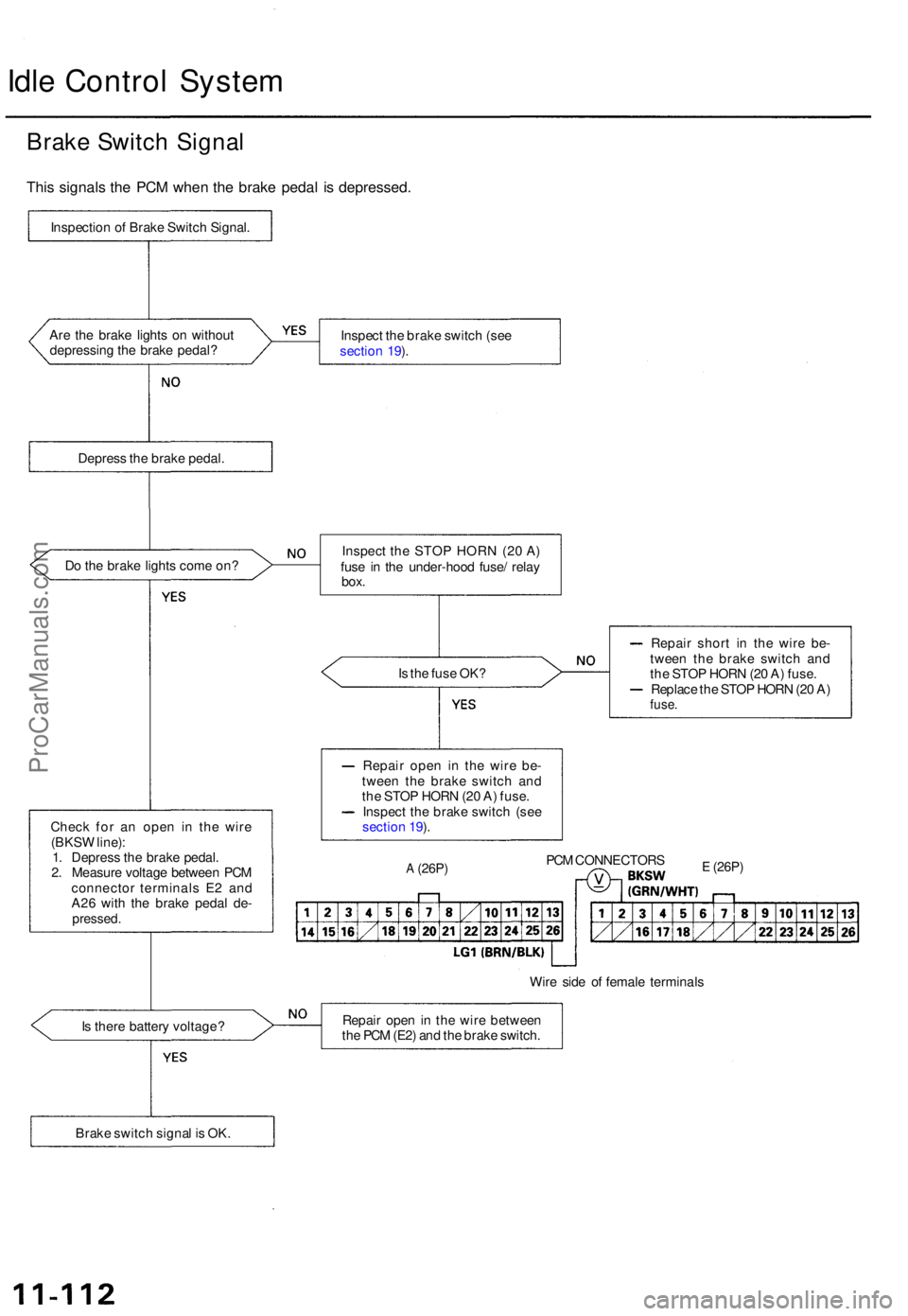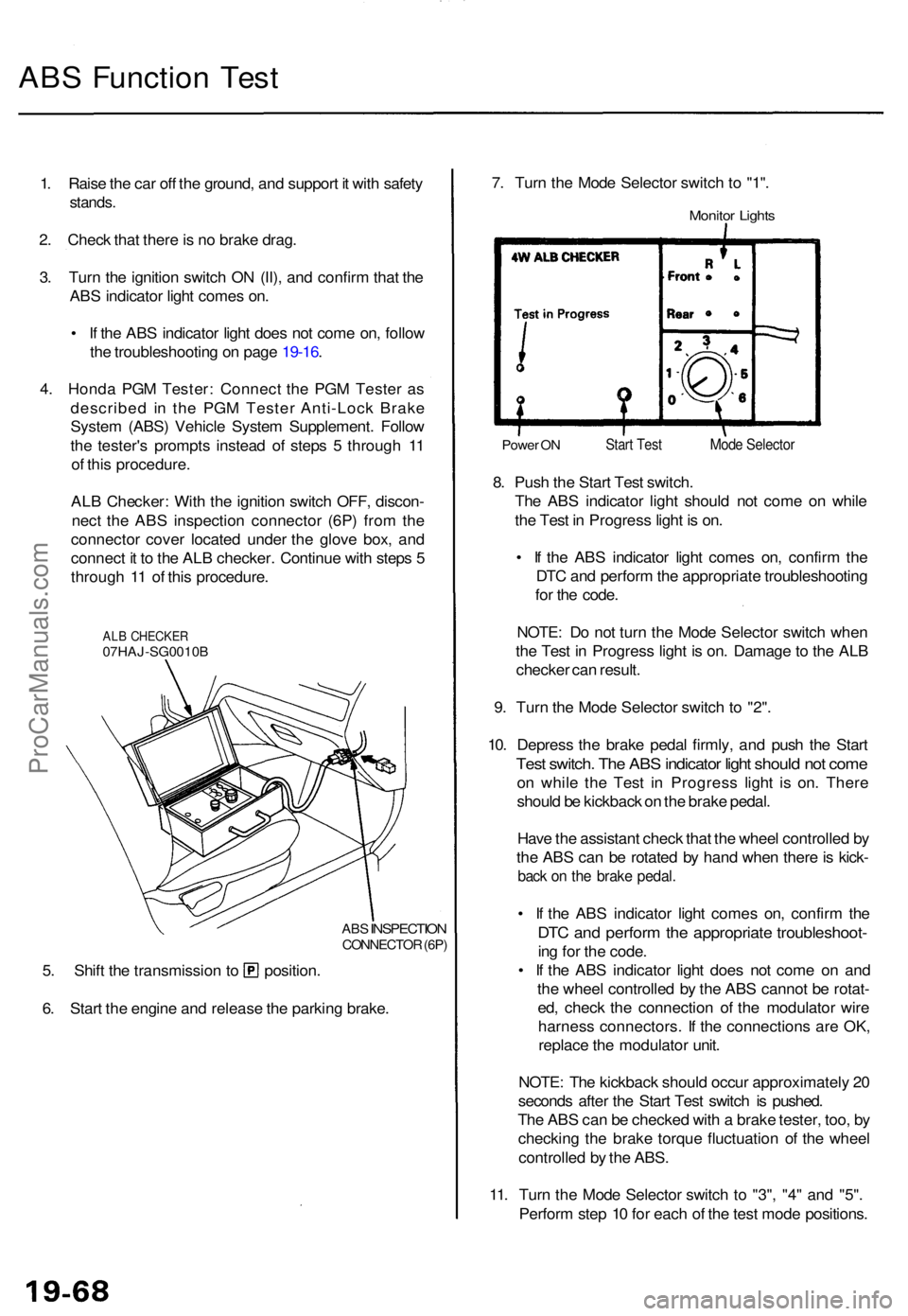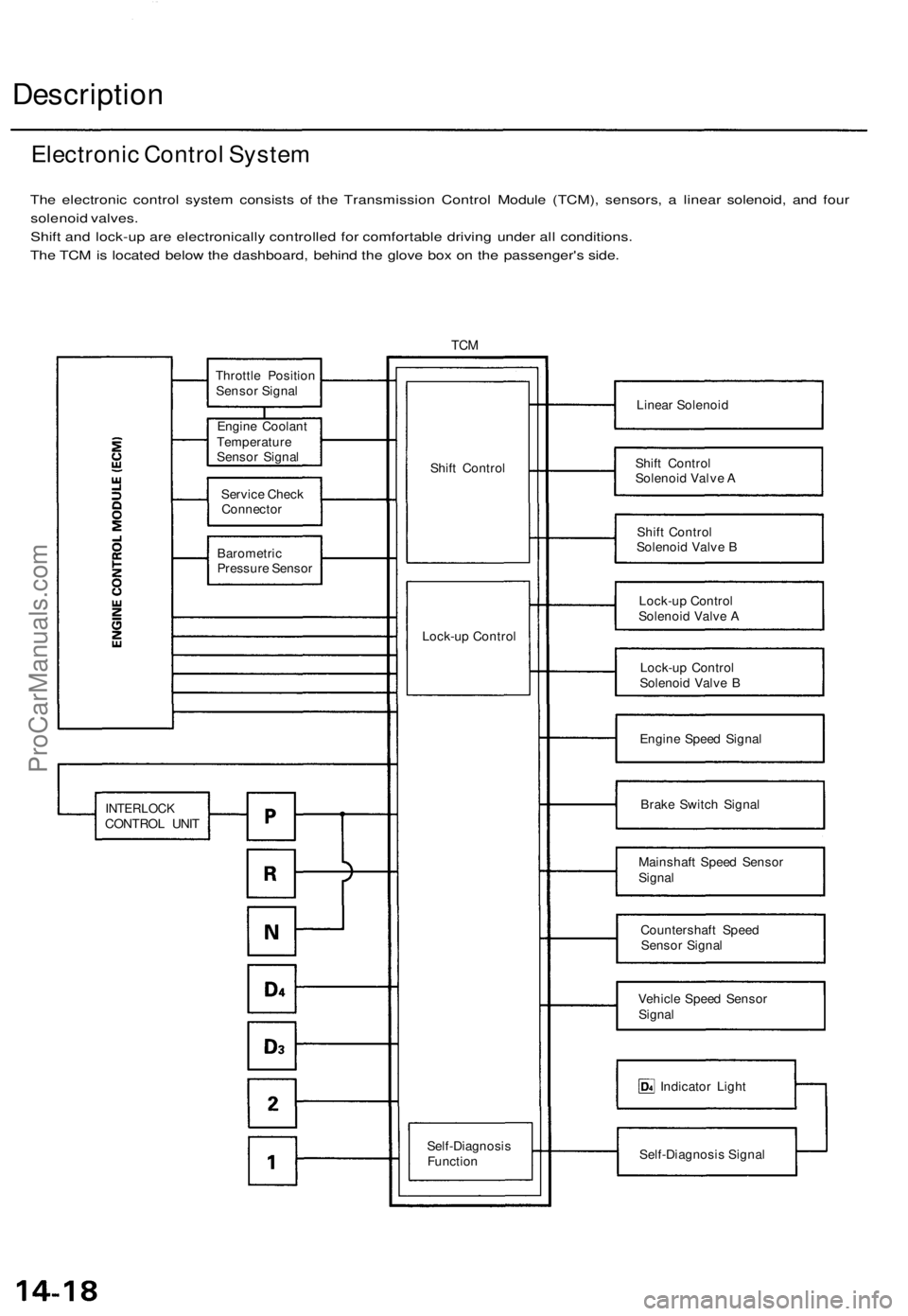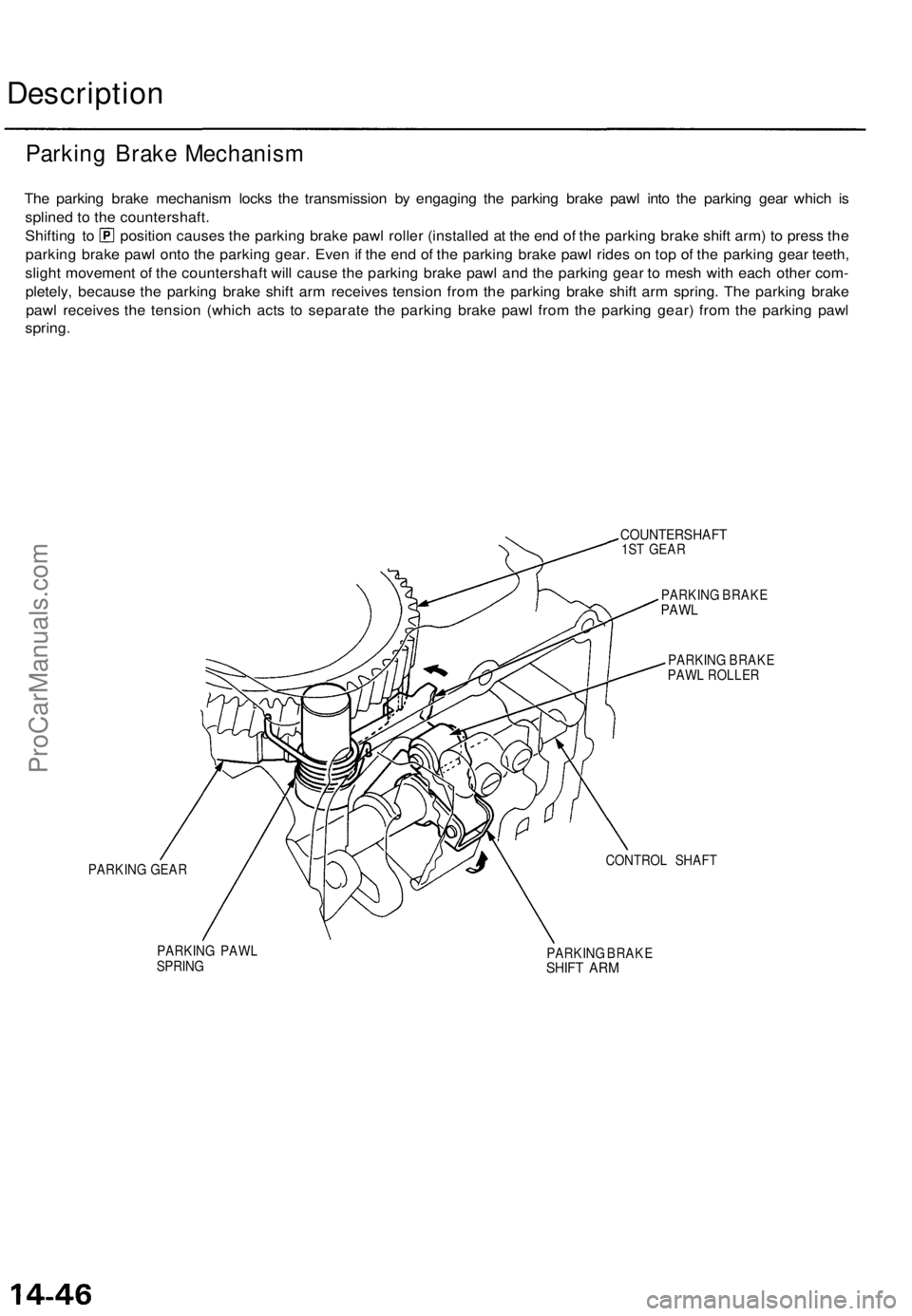1995 ACURA TL brake light
[x] Cancel search: brake lightPage 215 of 1771

Idle Contro l Syste m
Brake Switc h Signa l
This signal s th e PC M whe n th e brak e peda l i s depressed .
Inspection o f Brak e Switc h Signal .
Ar e th e brak e light s o n withou t
depressin g th e brak e pedal ? Inspec
t th e brak e switc h (se e
sectio n 19 ).
Depres s th e brak e pedal .
D o th e brak e light s com e on ?
Is th e fus e OK ?
Chec k fo r a n ope n i n th e wir e
(BKS W line) :
1 . Depres s th e brak e pedal .
2 . Measur e voltag e betwee n PC M
connecto r terminal s E 2 an d
A2 6 wit h th e brak e peda l de -
pressed .
Repair shor t i n th e wire be-
twee n th e brak e switc h an d
th e STO P HOR N (2 0 A ) fuse .
Replac e th e STO P HOR N (2 0 A )
fuse .
Repai r ope n i n th e wir e be -
twee n th e brak e switc h an d
th e STO P HOR N (2 0 A ) fuse .
Inspec t th e brak e switc h (se e
sectio n 19 ).
A (26P )PCM CONNECTOR SE (26P)
Wire sid e o f femal e terminal s
I s ther e batter y voltage ? Repai
r ope n in th e wir e betwee n
th e PC M (E2 ) an d th e brak e switch .
Brak e switc h signa l i s OK . Inspec
t th e STO P HOR N (2 0 A )
fus e i n th e under-hoo d fuse / rela y
box.
ProCarManuals.com
Page 508 of 1771

Troubleshooting Precautions
ABS Indicator Light:
The ABS indicator light comes on for three seconds and then goes off when the control unit detects no problem during the
initial diagnosis right after the engine starts. However, the ABS indicator light can stay on for up to 40 seconds when the
control unit starts to check for pump overrun, etc. during the initial diagnosis. The ABS indicator light comes on, and the
ABS control unit memorizes the diagnostic trouble code (DTC) under certain conditions.
• The parking brake is applied for more than 30 seconds while the vehicle is being driven. (DTC 2-1)
• The transmission downshifted excessively. (DTC 4-1, 4-2)
• The vehicle loses traction, and the front wheels spin for more than one minute when starting from a stuck condition on
a muddy, snowy, or sandy road. (DTC 4-8)
• Tire adhesion is lost due to excessive cornering speed. (DTC 5, 5-4, 5-8)
• The vehicle is driven on an extremely rough road. (DTC 8-1)
• The vehicle is interfered by strong radio waves (noise), for example, illegal radio, etc. (DTC 8-2)
NOTE: If there is any trouble in the system, the ABS indicator light comes on during driving.
Diagnostic Trouble Code (DTC):
• When the control unit detects a problem and the ABS indicator light comes on, the control unit memorizes the DTC.
• The control unit has three memory registers. When a problem occurs, the control unit stores the DTC in the first memory
register. If another problem occurs, or the same problem occurs again, the control unit moves the first DTC to the next
memory register, and stores the second DTC in the first register. If there's a third problem occurrence, the two existing
DTCs are moved up one register, and the third DTC is stored in the first register. If problems continue to occur, the oldest
problem is moved out of the last register and lost, and the most recent problem is stored in the first register. When the
same problem occurs three times, the same DTC is stored in all memory registers. (Refer to the Symptom-to-System
Chart for diagnostic period.)
• The most recent DTC is indicated first, and the oldest DTC is indicated last.
• The DTCs are erased from the control unit when the ABS control unit +B2 power supply or connector is disconnected.
• The control unit's memory can be erased by disconnecting the ABS B2 fuse for more than three seconds.
Self-diagnosis:
• There are three self-diagnosises described below.
Initial diagnosis: Performed right after the engine starts until the ABS indicator light goes off.
Regular diagnosis: Continuously performed (under some conditions) after the ABS indicator light goes off until the
engine stops.
Individual part/system diagnosis: Diagnosis about a specific part/system under its operating conditions.
• The CPU (central processing unit) controls the following when it detects a problem during self-diagnosis:
Turns the ABS indicator light ON.
Turns the front and rear fail-safe relays off.
Stops the ABS control.
Stops the ABS pump. (The pump may work under some conditions.)
After the DTC is stored in the control unit, the CPU stops self-diagnosis.ProCarManuals.com
Page 509 of 1771

Kickback and Pump Operation:
• When the engine is started, the ABS control unit begins the initial diagnosis and operates the solenoid valve one time.
The kickback may be felt when the brake pedal is depressed.
• When the ABS control unit detects the pressure switch OFF signal during the initial diagnosis, it operates the pump
motor, and performs the pump motor over-run diagnosis and pump motor diagnosis. Therefore, there are two cases
where the pump motor operates or does not operate after the engine is started.
• Normally, after the initial diagnosis, the pump motor operates based on the pressure switch signal, regardless of the
vehicle speed.
Troubleshooting:
• When two or three DTCs are stored in the control unit, perform troubleshooting for the DTC that appears first.
• When a customer's reported problem cannot be verified on the car, ask the customer about the conditions when the
ABS indicator light came ON, and test-drive the car under those conditions, if possible. When the ABS indicator light
does not come ON during the test, check for loose terminals and check by shaking the harnesses and connectors while
following the flowchart.
• The connector terminal numbers are viewed from the wire side for the female terminals, and from the terminal side for
the male terminals.
• After the repair is completed, test-drive the car and check that the ABS indicator light does not come ON again during
the test. (Refer to the Symptom-to-System Chart for diagnostic period.)ProCarManuals.com
Page 514 of 1771

ABS Functio n Tes t
1. Rais e th e ca r of f th e ground , an d suppor t i t wit h safet y
stands .
2. Chec k tha t ther e is n o brak e drag .
3 . Tur n th e ignitio n switc h O N (II) , an d confir m tha t th e
AB S indicato r ligh t come s on .
• I f th e AB S indicato r ligh t doe s no t com e on , follo w
th e troubleshootin g o n pag e 19-16 .
4 . Hond a PG M Tester : Connec t th e PG M Teste r a s
describe d i n th e PG M Teste r Anti-Loc k Brak e
Syste m (ABS ) Vehicl e Syste m Supplement . Follo w
th e tester' s prompt s instea d o f step s 5 throug h 1 1
o f thi s procedure .
AL B Checker : Wit h th e ignitio n switc h OFF , discon -
nec t th e AB S inspectio n connecto r (6P ) fro m th e
connecto r cove r locate d unde r th e glov e box , an d
connec t i t t o th e AL B checker . Continu e wit h step s 5
throug h 1 1 o f thi s procedure .
ALB CHECKE R07HAJ-SG0010 B
ABS
INSPECTIO NCONNECTO R (6P )
5. Shif t th e transmissio n t o position .
6 . Star t th e engin e an d releas e th e parkin g brake . 7
. Tur n th e Mod e Selecto r switc h t o "1" .
Monito r Light s
Powe r O NStar t Tes t
8. Pus h th e Star t Tes t switch .
Th e AB S indicato r ligh t shoul d no t com e o n whil e
th e Tes t i n Progres s ligh t i s on .
• I f th e AB S indicato r ligh t come s on , confir m th e
DT C an d perfor m th e appropriat e troubleshootin g
fo r th e code .
NOTE : D o no t tur n th e Mod e Selecto r switc h whe n
th e Tes t i n Progres s ligh t i s on . Damag e to th e AL B
checke r ca n result .
9 . Tur n th e Mod e Selecto r switc h t o "2" .
10 . Depres s th e brak e peda l firmly , an d pus h th e Star t
Test switch . Th e AB S indicato r ligh t shoul d no t com e
on whil e th e Tes t i n Progres s ligh t i s on . Ther e
shoul d b e kickbac k o n th e brak e pedal .
Hav e th e assistan t chec k tha t th e whee l controlle d b y
th e AB S ca n b e rotate d b y han d whe n ther e is kick -
back o n th e brak e pedal .
• I f th e AB S indicato r ligh t come s on , confir m th e
DT C an d perfor m th e appropriat e troubleshoot -
ing fo r th e code .
• I f th e AB S indicato r ligh t doe s no t com e o n an d
th e whee l controlle d b y th e AB S canno t b e rotat -
ed , chec k th e connectio n o f th e modulato r wir e
harnes s connectors . I f th e connection s ar e OK ,
replac e th e modulato r unit .
NOTE : Th e kickbac k shoul d occu r approximatel y 2 0
second s afte r th e Star t Tes t switc h i s pushed .
Th e AB S can be checke d wit h a brak e tester , too , b y
checkin g th e brak e torqu e fluctuatio n o f th e whee l
controlle d b y th e ABS .
11 . Tur n th e Mod e Selecto r switc h t o "3" , "4 " an d "5" .
Perfor m ste p 1 0 fo r eac h o f th e tes t mod e positions .
Mode Selecto r
ProCarManuals.com
Page 537 of 1771

Diagnostic Trouble Code (DTC)
DTC Erasure
1. Pull the parking brake lever up.
2. Push and hold the TCS switch, then turn the ignition switch ON (II).
3. Hold the TCS switch pushed for four seconds (do not release the TCS switch), then release the TCS switch for less than
six seconds.
4. After three seconds, the TCS indicator light go off three times, then turn it on. It means that the DTC is erased.
NOTE:
• Follow these steps exactly. If you connect the SCS service connector and/or release the parking brake lever during
these steps, the DTC will not be erased.
• If the TCS indicator light blinks repeatedly, replace the TCS control unit.
Standard Indication Pattern
Abnormal Indication PatternProCarManuals.com
Page 889 of 1771

Brake Switc h Signa l
This signal s th e EC M whe n th e brak e peda l i s depressed .
Inspection o f Brak e Switc h Signal .
Are th e brak e light s o n withou tdepressin g th e brak e pedal ?Inspec t th e brak e switc h (se e sectio n 19 ).
Depres s th e brak e pedal .
D o th e brak e light s com e on ?
Is th e fus e OK ?
Chec k fo r a n ope n i n th e wir e(BKS W line) :
1 . Depres s th e brak e pedal .
2 . Measur e voltag e betwee n EC M
connecto r terminal s D1 2 an d
A26 wit h th e brak e peda l de -pressed . Repai
r shor t i n th e wir e be -
twee n th e brak e switc h an d
th e STO P HOR N (2 0 A ) fuse .
Replac e th e STO P HOR N (2 0 A )
fuse .
ECM CONNECTOR S
A (26P)D (22P )
Wire sid e o f femal e terminal s
Is ther e batter y voltage ? Repai
r ope n i n th e wir e betwee n
th e EC M (D12 ) an d th e brak e
switch .
Brak e switc h signa l i s OK . Repai
r ope n i n th e wire be-
twee n th e brak e switc h an d
th e STO P HOR N (2 0 A ) fuse .
Inspec t th e brak e switc h (se e
sectio n 19 ).
ProCarManuals.com
Page 951 of 1771

Description
The electronic control system consists of the Transmission Control Module (TCM), sensors, a linear solenoid, and four
solenoid valves.
Shift and lock-up are electronically controlled for comfortable driving under all conditions.
The TCM is located below the dashboard, behind the glove box on the passenger's side.
TCM
Linear Solenoid
Shift Control
Solenoid Valve A
Shift Control
Solenoid Valve B
Lock-up Control
Solenoid Valve A
Lock-up Control
Solenoid Valve B
Engine Speed Signal
Brake Switch Signal
Mainshaft Speed Sensor
Signal
Countershaft Speed
Sensor Signal
Vehicle Speed Sensor
Signal
Indicator Light
Self-Diagnosis Signal
Electronic Control System
Shift Control
Lock-up Control
Throttle Position
Sensor Signal
Engine Coolant
Temperature
Sensor Signal
Service Check
Connector
Barometric
Pressure Sensor
INTERLOCK
CONTROL UNIT
Self-Diagnosis
FunctionProCarManuals.com
Page 971 of 1771

Description
The parking brake mechanism locks the transmission by engaging the parking brake pawl into the parking gear which is
splined to the countershaft.
Shifting to position causes the parking brake pawl roller (installed at the end of the parking brake shift arm) to press the
parking brake pawl onto the parking gear. Even if the end of the parking brake pawl rides on top of the parking gear teeth,
slight movement of the countershaft will cause the parking brake pawl and the parking gear to mesh with each other com-
pletely, because the parking brake shift arm receives tension from the parking brake shift arm spring. The parking brake
pawl receives the tension (which acts to separate the parking brake pawl from the parking gear) from the parking pawl
spring.
PARKING GEAR
COUNTERSHAFT
1ST GEAR
PARKING BRAKE
PAWL
PARKING BRAKE
PAWL ROLLER
CONTROL SHAFT
PARKING PAWL
SPRING
PARKING BRAKE
SHIFT ARM
Parking Brake MechanismProCarManuals.com